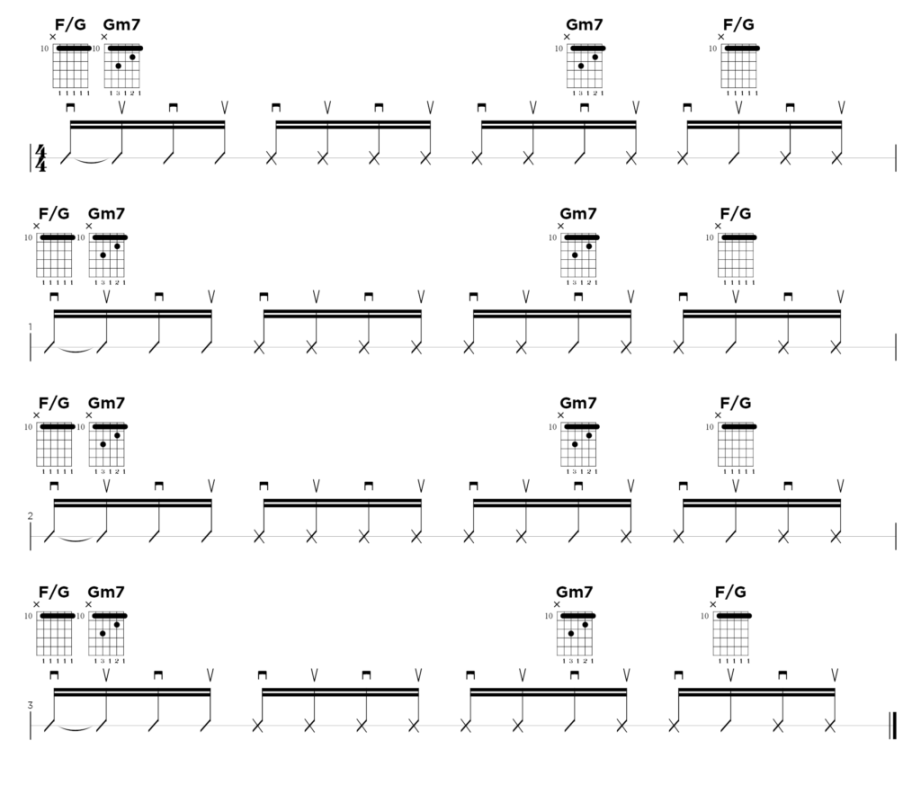—
Guitar Rhythm Patterns: Your Guide to Keeping the Groove Going
So, you’ve got your guitar, you know some Chords, but something’s missing. That “something” is rhythm. It’s the heartbeat of music, the thing that makes you tap your foot and nod your head. Without a solid rhythm, your chords are just floating in space. Let’s dive into the world of guitar rhythm patterns and get you grooving.
Understanding the Basics: What is Rhythm?

Before we get into specific patterns, let’s talk about the foundation. Rhythm, in its simplest form, is the arrangement of sounds and silences through time. It’s about how long you hold a note, when you play it, and when you don’t. In music, we break time into measures (or bars), and each measure is divided into beats.
Think of it like this: if you’re playing a song in 4/4 time (which most songs are), you’ll count “1, 2, 3, 4” over and over. Each number represents a beat. Your rhythm patterns are how you fill those beats with strums or individual notes.
Simple Down-Strumming: The Building Block
Let’s start with the most basic pattern: down-strumming on every beat. This is perfect for learning chords and getting a feel for the rhythm.
How to do it: Just strum down on each beat. If you’re counting “1, 2, 3, 4,” you’re strumming on each number.
Adding Up-Strums: The 8th Note Feel
Now, let’s add some complexity by incorporating up-strums. This gives us an 8th-note feel, meaning we’re playing twice as many notes in the same amount of time.
How to do it: Strum down on the numbered beats (“1, 2, 3, 4”) and up on the “and” between the numbers (“1 and 2 and 3 and 4 and”).
The Classic Rock Rhythm: Down-Down-Up-Up-Down-Up
This is a staple in rock and pop music. It’s versatile and can be used in a variety of songs.
How to do it: Strum down on the first two beats, up on the third and fourth, down on the fifth, and up on the sixth. If you’re counting in 8th notes, it’s: Down-Down-Up-Up-Down-Up (rest-rest).
The Reggae/Ska Up-Strum: Emphasizing the Off-Beats
Reggae and ska music are known for their distinctive up-strumming patterns, emphasizing the off-beats.
How to do it: In its simplest form, you’re strumming only the up strums, on the “and” of each beat.
Adding Muting: The Chunking Sound
Muting, or palm muting, adds a percussive element to your rhythm. It’s a technique where you rest the side of your picking hand on the strings near the bridge, creating a “chunking” sound.
How to do it: Combine muting with your strumming patterns. For example, you can mute the down-strums and let the up-strums ring out.
Varying Your Strumming Intensity: Dynamics
Don’t just strum at the same volume all the time. Varying your strumming intensity, or dynamics, can make your rhythm more expressive.
How to do it: Strum louder on certain beats or softer on others. Experiment with accenting different parts of the pattern.
Mixing and Matching Patterns: Creating Your Own Groove
The real fun starts when you begin mixing and matching different patterns. Don’t be afraid to experiment and create your own unique groove.
How to do it: Take elements from different patterns and combine them. For example, you could use the classic rock pattern but add some muting.
Listening and Learning: The Key to Improvement
The best way to learn rhythm patterns is to listen to music and try to replicate what you hear. Pay attention to the guitar parts and try to figure out the strumming patterns.
How to do it: Listen to your favorite songs and try to play along. Use online resources and tutorials to learn different patterns.
Conclusion
Rhythm is the foundation of music, and mastering guitar rhythm patterns is essential for any guitarist. It takes time and practice, but with dedication, you’ll be able to create your own grooves and bring your music to life. Start with the basics, experiment with different patterns, and most importantly, have fun. Don’t be afraid to get creative and develop your own style. Remember, the journey of learning guitar rhythm is a continuous one, so keep practicing, keep listening, and keep grooving.

